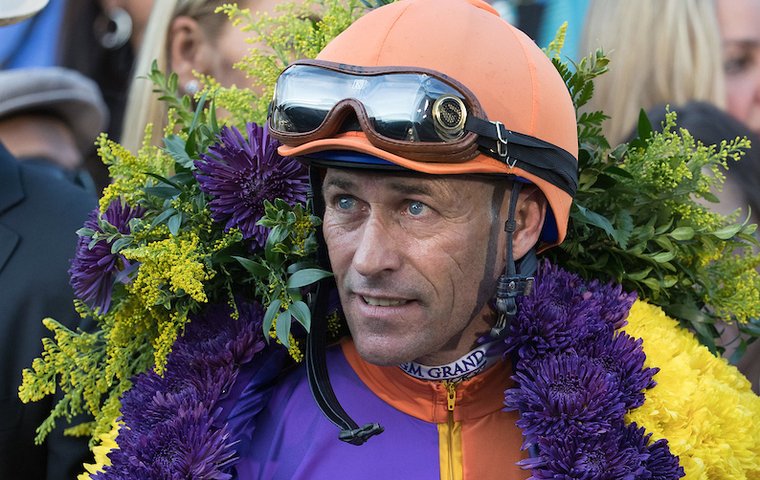
The end of November last year, a nasty accident in the post parade at Del Mar in California closed the door on the career of superstar jockey Gary Stevens, one of the modern era’s most recognizable and decorated talents in the saddle. Not that the world stopped revolving for him that day.
Since then, Stevens, now 56, has undergone successful neck surgery, has unveiled a presenting gig on Fox Sports television, and has continued his work on the board of directors for the Thoroughbred Idea Foundation, a thinktank for tackling racing’s problems. “What we’re trying to do is solve problems that are solveable, and get something done quickly,” Stevens said, of the foundation’s approach.
Here, taking part in TRC’s fortnightly What They’re Thinking series, the three-time Kentucky Derby-winning rider focuses on how the sport could be improved in the U.S. - and gives a nod to some of the racing figures he respects the most.
Who do you believe is the most important figure in the history of racing around the world?
To me, it’s probably [U.S. trainer] Wayne Lukas. I’m a huge fan of the master. He changed the way everything gets done, and in tutoring some of the greatest trainers to come up beneath him. His management skills and work ethic and business dealings at the sales and in developing people, I think he would have to be the most influential person.
Todd Pletcher and Kiaran McLaughlin and Dallas Stewart, these guys all learned his management skills. Same with Michael McCarthy, who’s a student of Pletcher. You can walk into any one of their barns, and you can’t tell who’s barn you’re in other than the plaque on the wall, because they run the same operation as Lukas. Everything meticulously done in every one of those barns. That’s management skills, man, to be that successful for that long.
Which is your favourite venue and race (anywhere in the world)?
I have four favorite places, really in no particular order, starting with Santa Anita, the most spectacular track. It’s a pleasure to go there every day, even for training.
Longchamp – I’ve never ridden in the Arc, but it’s my favorite race to watch. It’s a tricky course to ride, challenging. One year, I’d flown to France – Sheikh Mohammed was interested in me becoming a contract rider. I rode out on the gallops for Andre Fabre, and he had me work this big chestnut horse. He worked unbelievable. [Fabre] says, ‘why don’t you stay an extra week, this horse is running in the Arc next week.’ But I had to get back to California to ride a horse in the Pomona Derby for Laz Barrera. The [Fabre] horse happened to be Trempolino [winner of the 1987 Arc].
Then there’s the Curragh, it’s so special. Talk about beautiful, and peaceful, too. Then, of course, there’s Ascot. Those are my four.
What is your fondest memory in racing?
I guess the one that really put me on the map, showed I could be a real big-race rider, that would have to be the 1988 Kentucky Derby [his first] on Winning Colors (see video above). That’s the one that jumps out at me all the time. The second [Thunder Gulch, 1995] was better than the first, and the third [Silver Charm, 1997] was better than the second, but the first one is the one that got me where I am and who I am.
I also miss that whole time I had with [Sir] Michael Stoute. If I had any regrets in my career, which I don’t, but if I did, it would be in the choice I had to make of coming back to America to ride for the Thoroughbred Corporation or ride for Michael Stoute. I wasn’t real healthy – my knees were bothering me. No one really knew, but Stoute was helping me. Looking back, that was one of the most enjoyable times of my career, riding for Michael Stoute, and the relationship we developed over a short period of time. That relationship is still strong today. He’s a special, special man, with a photographic memory.
What do you see as the biggest challenge racing faces today?
The biggest problem we face [in America] is not having a national league, like the NFL. I think it can be accomplished, and it needs to be for us to move forward as a legitimate business operating to get out of the red into the black.
Just think about it. There’s 33 different racing jurisdictions and they all have different rules and we all have to be licensed at every different jurisdiction. When I traveled to Europe or Japan, my American license worked over there. I think we need nationalized rules for licensing and medication thresholds. The easiest thing to fix that would be zero [race-day] medications, but I don’t see that happening in America [quickly]. That’s something that can’t be fixed overnight.
If you could change one thing in racing, what would it be?
It’s the same answer – we need to come together as a nation of horsemen with a commissioner.
In my mind it’s a simple fix that’s not simple, as we’re going to get all those different jurisdictions who say we’re going to lose money in licensing. But we’re not going to lose money in licensing – we’re going to bring people in. You don’t know how many owners and trainers say, ‘you know what, it’s too much of a hassle to send my horse out of state.’ It shouldn’t be like that. Once licensed, licensed everywhere.
We also need to see the smaller tracks succeed as well. Good horses can come from anywhere, and good horsemen can come from anywhere. People move up from the minor leagues to the majors. We need these smaller tracks and we need employment opportunities in this business.


